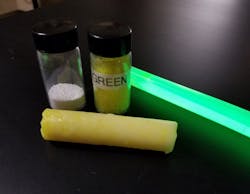Putting Glow Stick Tech in a Marker
Glow sticks—or chemlights, as they’re known in the military—have proven useful in the battlefield and other military situations, and Air Force researchers have recently discovered a way to make them even more useful.
They are already used by soldiers as wands for directing vehicles and providing emergency lighting, and the fluid inside can be splashed onto a surface to mark routes or positions.
These lights work through chemiluminescence, a reaction that generates light by combining chemical substances. In chemlights, this reaction is typically triggered by breaking or snapping an inner chamber to let two substances mix. Depending on the mixture ratio, these devices provide light for anywhere from a few minutes to several hours. They can be dyed various colors or even made with dyes invisible to the naked eye.
The AFRL Materials and Manufacturing Directorate Technology Transfer office recently licensed in-house developed microencapsulated chemiluminescent materials to startup company Battle Sight Technologies LLC. These materials can be used in glow stick “crayons” to write messages or mark items in the field.
But chemlights are single-use devices. This means soldiers in the field may have to carry hundreds of them to accomplish a singular task. It is also somewhat awkward to use the chemiluminescent fluid to write messages or draw complex figures.
To address these issues, engineers at the Air Force Research Laboratory have microencapsulated the activating chemical substances put the tiny capsules in a medium that can be used for writing or applying the material, much like a crayon or a lip balm applicator.
The pressure of writing easily breaks the capsules, creating the glowing effect. This means a single stick can be used precisely and accurately many times, resulting in numerous benefits for the military. It lightens the size and weight of the load that needs to be carried in the field, and it saves money.
To further advance its development and use, the AFRL Materials and
Battle Sight Technologies LLC, a Dayton, Ohio-based startup company founded by military veterans, will try to commercialize the technology and reduce costs even further. The company is currently working on prototypes of an IR writing device called the MARC (Marking Appliance Reusable Chemiluminescent). Once the initial prototype production run is complete, the marker will go directly to field tests and evaluation, possibly as early as Spring 2018. If all goes well, the company’s goal is to have a fieldable product by late summer.
Battlesight Technologies can foreseeably market its product for consumer use and use the AFRL technology to develop other products as well, but the firm’s current focus is on military applications.


